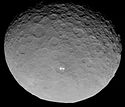
A protoplanetary disk is a rotating circumstellar disc of dense gas and dust surrounding a young newly formed star, a T Tauri star, or Herbig Ae/Be star. The protoplanetary disk may also be considered an accretion disk for the star itself, because gases or other material may be falling from the inner edge of the disk onto the surface of the star. This process should not be confused with the accretion process thought to build up the planets themselves. Externally illuminated photo-evaporating protoplanetary disks are called proplyds.

A planetary system is a set of gravitationally bound non-stellar objects in or out of orbit around a star or star system. Generally speaking, systems with one or more planets constitute a planetary system, although such systems may also consist of bodies such as dwarf planets, asteroids, natural satellites, meteoroids, comets, planetesimals and circumstellar disks. The Sun together with the planetary system revolving around it, including Earth, forms the Solar System. The term exoplanetary system is sometimes used in reference to other planetary systems.

BD+20°307 is a close binary star system approximately 300 light-years away in the constellation Aries. The system is surrounded by a dusty ring, and probably orbited by a 0.48M☉ white dwarf on a wide orbit.
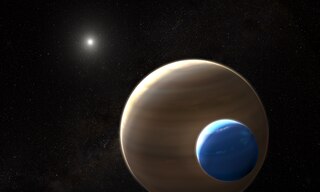
An exomoon or extrasolar moon is a natural satellite that orbits an exoplanet or other non-stellar extrasolar body.

Giclas 29-38, also known as ZZ Piscium, is a variable white dwarf star of the DAV type, whose variability is due to large-amplitude, non-radial pulsations known as gravity waves. It was first reported to be variable by Shulov and Kopatskaya in 1974. DAV stars are like normal white dwarfs but have luminosity variations with amplitudes as high as 30%, arising from a superposition of vibrational modes with periods from 100 to 1,000 seconds. Large-amplitude DAVs generally differ from lower-amplitude DAVs by having lower temperatures, longer primary periodicities, and many peaks in their vibrational spectra with frequencies which are sums of other vibrational modes.

A debris disk, or debris disc, is a circumstellar disk of dust and debris in orbit around a star. Sometimes these disks contain prominent rings, as seen in the image of Fomalhaut on the right. Debris disks are found around stars with mature planetary systems, including at least one debris disk in orbit around an evolved neutron star. Debris disks can also be produced and maintained as the remnants of collisions between planetesimals, otherwise known as asteroids and comets.

HR 8799 is a roughly 30 million-year-old main-sequence star located 133.3 light-years away from Earth in the constellation of Pegasus. It has roughly 1.5 times the Sun's mass and 4.9 times its luminosity. It is part of a system that also contains a debris disk and at least four massive planets. Those planets, along with Fomalhaut b, were the first exoplanets whose orbital motion was confirmed by direct imaging. The star is a Gamma Doradus variable: its luminosity changes because of non-radial pulsations of its surface. The star is also classified as a Lambda Boötis star, which means its surface layers are depleted in iron peak elements. It is the only known star which is simultaneously a Gamma Doradus variable, a Lambda Boötis type, and a Vega-like star.

Fomalhaut b, formally named Dagon, is a directly imaged extrasolar object and former candidate planet observed near the A-type main-sequence star Fomalhaut, approximately 25 light-years away in the constellation of Piscis Austrinus. The object's discovery was initially announced in 2008 and confirmed in 2012 via images taken with the Advanced Camera for Surveys (ACS) on the Hubble Space Telescope. Under the working hypothesis that the object was a planet, it was reported in January 2013 that it had a highly elliptical orbit with a period of 1,700 Earth years. The object was one of those selected by the International Astronomical Union as part of NameExoWorlds, their public process for giving proper names to exoplanets. The process involved public nomination and voting for the new name. In December 2015, the IAU announced the winning name was Dagon.

Paul Kalas is a Greek American astronomer known for his discoveries of debris disks around stars. Kalas led a team of scientists to obtain the first visible-light images of an extrasolar planet with orbital motion around the star Fomalhaut, at a distance of 25 light years from Earth. The planet is referred to as Fomalhaut b.

An exoplanet is a planet located outside the Solar System. The first evidence of an exoplanet was noted as early as 1917, but was not recognized as such until 2016; no planet discovery has yet come from that evidence. What turned out to be the first detection of an exoplanet was published among a list of possible candidates in 1988, though not confirmed until 2003. The first confirmed detection came in 1992, with the discovery of terrestrial-mass planets orbiting the pulsar PSR B1257+12. The first confirmation of an exoplanet orbiting a main-sequence star was made in 1995, when a giant planet was found in a four-day orbit around the nearby star 51 Pegasi. Some exoplanets have been imaged directly by telescopes, but the vast majority have been detected through indirect methods, such as the transit method and the radial-velocity method. As of 1 May 2024, there are 5,662 confirmed exoplanets in 4,169 planetary systems, with 896 systems having more than one planet. This is a list of the most notable discoveries.
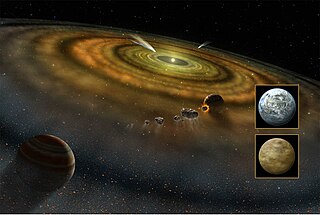
An exocomet, or extrasolar comet, is a comet outside the Solar System, which includes rogue comets and comets that orbit stars other than the Sun. The first exocomets were detected in 1987 around Beta Pictoris, a very young A-type main-sequence star. There are now a total of 27 stars around which exocomets have been observed or suspected.

A sub-Earth is a planet "substantially less massive" than Earth and Venus. In the Solar System, this category includes Mercury and Mars. Sub-Earth exoplanets are among the most difficult type to detect because their small sizes and masses produce the weakest signal. Despite the difficulty, one of the first exoplanets found was a sub-Earth around a millisecond pulsar PSR B1257+12. The smallest known is WD 1145+017 b with a size of 0.15 Earth radii, or somewhat smaller than Pluto. However, WD 1145+017 b is not massive enough to qualify as a sub-Earth classical planet and is instead defined as a minor, or dwarf, planet. It is orbiting within a thick cloud of dust and gas as chunks of itself continually break off to then spiral in towards the star, and within around 5,000 years it will have more-or-less disintegrated.
WD 1145+017 is a white dwarf approximately 476 light-years from Earth in the constellation of Virgo. It is the first white dwarf to be observed with a transiting minor planet orbiting it.
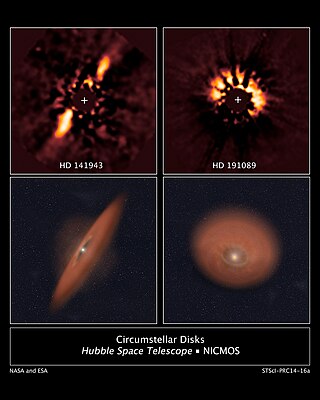
A circumstellar disc is a torus, pancake or ring-shaped accretion disk of matter composed of gas, dust, planetesimals, asteroids, or collision fragments in orbit around a star. Around the youngest stars, they are the reservoirs of material out of which planets may form. Around mature stars, they indicate that planetesimal formation has taken place, and around white dwarfs, they indicate that planetary material survived the whole of stellar evolution. Such a disc can manifest itself in various ways.
Fomalhaut C, also designated LP 876-10, is the distant third star of the Fomalhaut system. It is about five degrees from Fomalhaut, roughly halfway between it and the Helix Nebula. It is currently 2.5 light-years (0.77 pc) from Fomalhaut (A), and 3.2 light-years away from Fomalhaut B. The entire system is only around 25 light-years (7.7 pc) from the Solar System. It was originally catalogued as a lone red dwarf, until October 2013, when Eric Mamajek announced that the star had a distance, velocity and color-magnitude position consistent with it being part of the Fomalhaut system. It was most likely catalogued with no relation to Fomalhaut due to the fact that it is in the Aquarius constellation, while the rest of the system are in the Piscis Austrinus constellation.

WD 1145+017 b, is a confirmed exoasteroid or minor planet orbiting around and being vaporized by the white dwarf star WD 1145+017, likely one of multiple such objects around this star. It was discovered by NASA's Kepler spacecraft on its "Second Light" mission. It is located about 476 light-years away from Earth in the constellation of Virgo. The object was found by using the transit method, in which the dimming effect that a planet causes as it crosses in front of its star is measured.

In astronomy, a disrupted planet is a planet or exoplanet or, perhaps on a somewhat smaller scale, a planetary-mass object, planetesimal, moon, exomoon or asteroid that has been disrupted or destroyed by a nearby or passing astronomical body or object such as a star. Necroplanetology is the related study of such a process.
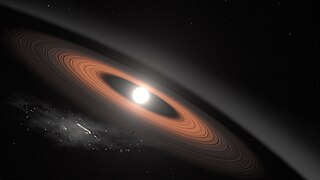
LSPM J0207+3331 is, as of 2023, the oldest and coldest known white dwarf star to host a circumstellar disk, located 145 light-years from Earth. It was discovered in October 2018 by a volunteer participating in the Backyard Worlds citizen science project.

WD 0145+234 is a white dwarf star approximately 95 ly (29 pc) from Earth in the constellation of Aries that has been associated with studies suggesting that a very large exoasteroid near the star was substantially disrupted, resulting in a considerable amount of dust and debris around the star. Alternatively, the outburst around WD 0145+234 is explained with ongoing collisions between planetesimals inside the dusty debris disk around the white dwarf.

Solar System belts are asteroid and comet belts that orbit the Sun in the Solar System in interplanetary space. The Solar System has both major and minor asteroid and comet belts in the inner Solar System. The Solar System is unique in that it has multiple belts. The observation of other planetary systems has found these systems to have no asteroid belts or one vast asteroid belt. The stars Fomalhaut, HD 69830 and Epsilon Eridani are examples of systems with one large asteroid belt. The Solar System belts size and placement are mostly a result of the Solar System having four giant planets: Jupiter, Saturn, Uranus and Neptune far from the sun. The giant planets must be in the correct place, not too close or too far from the sun for a system to have Solar System belts.



















